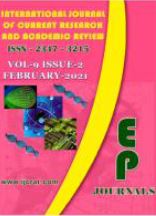Abstract Volume:9 Issue-2 Year-2021 Original Research Articles
 |
Online ISSN : 2347 - 3215 Issues : 12 per year Publisher : Excellent Publishers Email : editorijcret@gmail.com |
2Jimma Research Center, P.O. Box 192, Jimma, Ethiopia
The objectives of the study were to evaluate the yield performance of each genotype in relation to each environment, to examine the possible existence of different mega environments and to identify the winning genotype for each mega environment using GGE bi-plot method. Ten finger millet varieties which were for the experiment. The experiment was laid out using randomized complete block design with four replications in all testing sites. The plot size was four harvestable rows and spacing between rows was 40cm with the length of 5m long. All management practices such as cultivation, fertilization and weeding were done based on the recommendations for each test sites. Data for all relevant agronomic traits were collected, but only plot yield data converted to qt/ha was subjected to statistical analysis. The mean grain yield of the varieties was ranged from 18.9qt/ha to 15.3qt/ha. The highest mean was harvested from the variety Gudetu (18.9qt/ha) and the lowest from variety Meba (15.3qt/ha).Out of ten varieties, six varieties had grain yield below the average. Among the environments, the LM2017 and GM2019 had below the mean average yields. The highest yield were recorded in the environment BD2018 and BD2017 with mean yields of 25.6 and 24.5qt/ha respectively. A combined analysis of variance indicated that genotype, environment and GEI showed significant (P<0.001) differences among finger millet varieities. This result showed that finger millet yields were significantly influenced by environment, which accounted 78.7% of the total yield variation, while genotype and GEI explained 1.55 and 9.86% of the variation respectively. The partitioning of GGE through GGE biplot analysis showed that PC1 and PC2 accounted 46.3 and 27.2% of GGE sum of squares, respectively, explaining a total of 73.5% variation. GGE biplot identified G7 and BD19 as ideal genotype and environment respectively.
How to cite this article:
Tegegn Belete, Nesrya Bediru, Seid Beshir, Zenebech Teshome and Solomon Admasu. 2021. GGE bi-plot Analysis of Genotype by Environment Interaction in Finger Millet (Eleusine coracana (L.) Gaertn.) varieties in different Locations of Southwestern Ethiopia.Int.J.Curr.Res.Aca.Rev. 9(2): 26-38doi: https://doi.org/10.20546/ijcrar.2021.902.003



Quick Navigation
- Print Article
- Full Text PDF
- How to Cite this Article
- on Google
- on Google Scholor
- Citation Alert By Google Scholar
